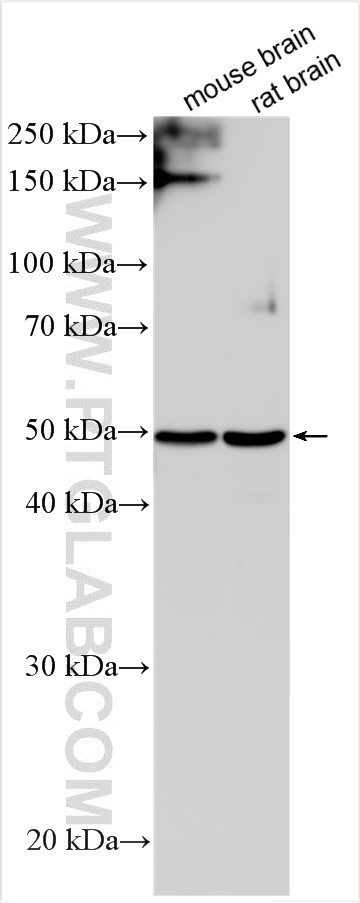验证数据展示
经过测试的应用
| Positive WB detected in | mouse brain tissue, rat brain tissue |
推荐稀释比
| 应用 | 推荐稀释比 |
|---|---|
| Western Blot (WB) | WB : 1:500-1:1000 |
| It is recommended that this reagent should be titrated in each testing system to obtain optimal results. | |
| Sample-dependent, Check data in validation data gallery. | |
产品信息
30570-1-AP targets CD200 in WB, ELISA applications and shows reactivity with Human, Mouse, Rat samples.
| 经测试应用 | WB, ELISA Application Description |
| 经测试反应性 | Human, Mouse, Rat |
| 免疫原 | Recombinant protein 种属同源性预测 |
| 宿主/亚型 | Rabbit / IgG |
| 抗体类别 | Polyclonal |
| 产品类型 | Antibody |
| 全称 | CD200 molecule |
| 别名 | CD200, CD200 molecule, MOX1, MOX2, MRC, OX 2, OX 2 membrane glycoprotein |
| 计算分子量 | 269 aa, 30 kDa |
| 观测分子量 | 50 kDa |
| GenBank蛋白编号 | BC022522 |
| 基因名称 | CD200 |
| Gene ID (NCBI) | 4345 |
| RRID | AB_3086365 |
| 偶联类型 | Unconjugated |
| 形式 | Liquid |
| 纯化方式 | Antigen affinity purification |
| UNIPROT ID | P41217 |
| 储存缓冲液 | PBS with 0.02% sodium azide and 50% glycerol , pH 7.3 |
| 储存条件 | Store at -20°C. Stable for one year after shipment. Aliquoting is unnecessary for -20oC storage. |
背景介绍
CD200, also known as OX2, is a type I transmembrane glycoprotein that belongs to the immunoglobulin superfamily (PMID: 3032785). It contains two extracellular immunoglobulin domains, a transmembrane and a cytoplasmic domain. CD200 is expressed on a variety of cell types, including thymocytes, B lymphocytes, a subset of T lymphocytes, follicular dendritic cells, neurons, and endothelial cells (PMID: 3032785; 10981966). CD200 binds to its receptor, CD200R, which is primarily expressed by myeloid and T cell lineage (PMID: 15187158). The CD200-CD200R interaction plays a role in immunosuppression and suppression of anti-tumor immune responses (PMID: 22020332).
实验方案
| Product Specific Protocols | |
|---|---|
| WB protocol for CD200 antibody 30570-1-AP | Download protocol |
| Standard Protocols | |
|---|---|
| Click here to view our Standard Protocols |
